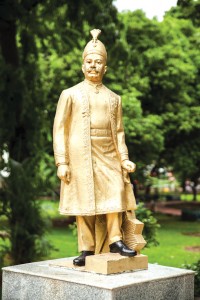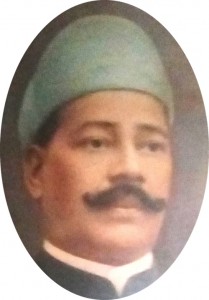Registered with the Registrar of Newspapers for India under R.N.I 53640/91
Vol. XXVI No. 07, July 16-31, 2016
Remembering a Raja
by Sriram V
Panagal Park is perhaps one of the best-known landmarks of our city, one that even new comers are familiar with.
 The repainted statue of the Rajah of Panagal in the Park named after him in
The repainted statue of the Rajah of Panagal in the Park named after him inT’Nagar
Though it is a vital lung for the T’Nagar area, it makes it to the news chiefly for the wrong reasons – the traffic congestion around it, the buildings that have come up on its periphery in flagrant violation of rules, and the multi-tiered parking complex that is forever on the verge of being built.
The man who gave the park its name is commemorated with a statue that gazes serenely at the chaos and cacophony that surrounds it. Certainly, T’ Nagar has not developed the way the Raja of Panagal would have wanted it to. But its commercial importance cannot be denied. In a way, it is a mixed legacy, as many other contributions of Panagal have been, though all of them were brought forward by him with the best of intentions and the highest of ideals. July 9th this year marked the 150th anniversary of his birth.
Though he is always referred to as the Raja of Panagal (Paanagal would be its correct pronunciation), that was an honorific that the British bestowed on him. Born Panaganti Ramarayaningar, he was of aristocratic stock, his family being landowners at Kalahasti. In keeping with the practice among upper-class families of the time, he was privately educated at first. He soon became proficient in Telugu and Sanskrit and then, on discovering that several of his playmates, also from titled gentry, were learning English, he acquired mastery over that language as well. In 1882, at the age of 16, he enrolled at the Triplicane Anglo-Vernacular High (now the Hindu Higher Secondary) School. Having completed his schooling there, he joined Presidency College, Madras, and graduated in 1893 with a BA degree in Telugu. He acquired his MA in Chemistry from the University of Madras in 1899. In the interim he obtained a BL degree at Law College. His achievements in scholastics surprised many and it led to the then Governor of Madras according to him a special honour – that of meeting him without prior appointment.
His scholarship in languages received encomiums from some other quarters as well. In 1910, Madras was rocked by the Radhika Santwanamu case, the first instance of a book being proscribed in India on grounds of obscenity. It was felt by many that the British had relied on biased counsel and that an objective expert ought to go through the book and decide the case on merits. V. Krishnaswamy Aiyer, then Member of the Governor’s Executive Council, was of the view that Ramarayaningar was best suited for this task. But the former’s death in 1911 put paid to that idea. Another person who swore by Ramarayaningar’s linguistic ability was Pammal Sambanda Mudaliar. The two had studied together in college. In1891, Mudaliar and his friends set up the Suguna Vilasa Sabha and were hardpressed for a script that they could act for their debut. They had watched Chirakari, a Telugu play staged by the Bellary Sarasa Vinodini Sabha, but lacked the proficiency to translate it into Tamil. Ramarayaningar obliged them by translating the play into English. This in turn was translated into Tamil by Sambanda Mudaliar.
His family background, his proficiency in languages and his oratorical skills made Ramarayaningar select public service as his chosen vocation. By way of a beginning, he successfully contested the elections for the North Arcot District Board. Within a short while he decided that this was too small a canvas for his vision and in 1912 stood for election to the Imperial Legislative Council, Delhi, as the representative of the Madras Landowners’ Association. He served for three years as a member of the Imperial Legislature where his debating style came in for great appreciation from the Viceroy, Lord Hardinge of Penshurst. In 1918, the Government conferred the title of Dewan Bahadur on him.
 Raja of Panagal.
Raja of Panagal.
Ramarayaningar did not neglect matters at the provincial level either. In 1915 he was elected President of the third Andhra conference. It was also at this time that he began involving himself in the emancipation of non-Brahmins in Madras Presidency. The Justice Party had then been formed in Madras by such leading lights as Dr. C. Natesa Mudaliar, Sir Pitty Theagaroya Chetty and Dr. T.M. Nair for this purpose and he too gravitated to this party. Thanks to his presence, the Justice Party began attracting a number of zamindars and landowners from Andhra, a membership that in the initial days was beneficial but would eventually prove to be its undoing. The party represented to the Government on the necessity for non-Brahmins to be given admission in colleges and also have assured Government jobs. In 1918, Ramarayaningar was sent to England as a representative of the Madras Landowners to depose before a parliamentary committee on the condition of non-Brahmins in South India.
The Morley-Minto reforms had resulted in the Indian Councils Act of 1909. Under it, the provinces of British India were to see an increase in the number of seats for Indians in the Provincial Legislative Councils, these being contested for the first time on the basis of a limited franchise. In Madras, the Justice Party won most of the seats in the Legislative Council when the elections were held in 1920, the Congress having decided to abstain. In accordance with the Morley-Minto reforms, the majority party in the legislature was invited to form the Government, this being a sum of three ministers who held some key but non-critical portfolios. It was a beginning, nevertheless, for Indians to have some say in governance. The leader of the Justice Party was Sir Pitty Theagaroya Chetty but he opted to continue playing a key role in the Corporation of Madras and the invitation to become First Minister for Madras went to A. Subbarayulu Reddiar. He was given the portfolios of Education, Excise and Public Works. Ramarayaningar became Minister in charge of Local Self Government and Kurma Venkata Reddy Rao Naidu was given the portfolio of Development. The newly elected council was declared in session by the Duke of Connaught on January 13, 1921. However, the First Minister resigned within six months, on grounds of ill-health. He passed away in November.
Meanwhile, the post of First Minister, or Premier, of Madras, was offered to Ramarayaningar and he accepted. His portfolios now included Health, Sanitation and Hindu Religious Establishments. He was to leave his impress on all these departments.
(To be continued)

